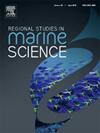First report on the occurrence of potentially toxic elements in coastal zones of the Cayos Cochinos Archipelago, Honduras
IF 2.4
4区 环境科学与生态学
Q3 ECOLOGY
引用次数: 0
Abstract
This first comprehensive report examines the spatial distribution and concentration of potentially toxic elements (PTE) in intertidal and supratidal zones across five islands of the Cayos Cochinos Archipelago, a marine protected area within the Meso-American Barrier Reef, Caribbean Sea. Seventy-five sand samples were collected during December 2022 and analyzed for chromium (Cr), cobalt (Co), zinc (Zn), arsenic (As), cadmium (Cd), lead (Pb), copper (Cu), and nickel (Ni) using inductively coupled plasma-optical spectrometry. The islets with the highest anthropogenic pressure exhibited the highest levels of As, Pb, Ni, Co, Cu, Zn, Cr, and Cd. Significant spatial variations in PTE-concentrations were observed among sampling locations, with the supratidal zone generally showing higher PTE accumulation than those levels of the intertidal zone, excepting Pb with the highest levels (25.44 µg g⁻¹ d.w.) in sands of the intertidal zone. The toxicity of PTEs can have significant consequences for aquatic organisms in these delicate ecosystems, and can disrupt food chains through bioaccumulation. Future investigations should focus on expanded elemental analysis, and comprehensive ecological risk assessments to better understand the long-term environmental routes of toxic elements in fragile coastal marine areas.
关于洪都拉斯科奇诺斯群岛沿海地区潜在有毒元素发生的第一份报告
这是第一份综合报告,研究了科奇诺斯群岛五个岛屿潮间带和潮上带潜在有毒元素(PTE)的空间分布和浓度。科奇诺斯群岛是加勒比海中美洲堡礁内的海洋保护区。研究人员于2022年12月采集了75份沙样,并利用电感耦合等离子体光谱法分析了铬(Cr)、钴(Co)、锌(Zn)、砷(As)、镉(Cd)、铅(Pb)、铜(Cu)和镍(Ni)的含量。在人类活动压力最大的胰岛中,As、Pb、Ni、Co、Cu、Zn、Cr和Cd的含量最高。不同采样地点的PTE浓度存在显著的空间差异,潮上带的PTE积累量普遍高于潮间带,但潮间带沙中Pb含量最高(25.44 µg g⁻¹d.w.)。pte的毒性可对这些脆弱生态系统中的水生生物造成严重后果,并可通过生物积累破坏食物链。未来的调查应侧重于扩大元素分析和综合生态风险评估,以更好地了解沿海脆弱海域有毒元素的长期环境路径。
本文章由计算机程序翻译,如有差异,请以英文原文为准。
求助全文
约1分钟内获得全文
求助全文
来源期刊

Regional Studies in Marine Science
Agricultural and Biological Sciences-Ecology, Evolution, Behavior and Systematics
CiteScore
3.90
自引率
4.80%
发文量
336
审稿时长
69 days
期刊介绍:
REGIONAL STUDIES IN MARINE SCIENCE will publish scientifically sound papers on regional aspects of maritime and marine resources in estuaries, coastal zones, continental shelf, the seas and oceans.
 求助内容:
求助内容: 应助结果提醒方式:
应助结果提醒方式:


